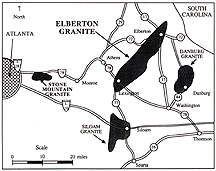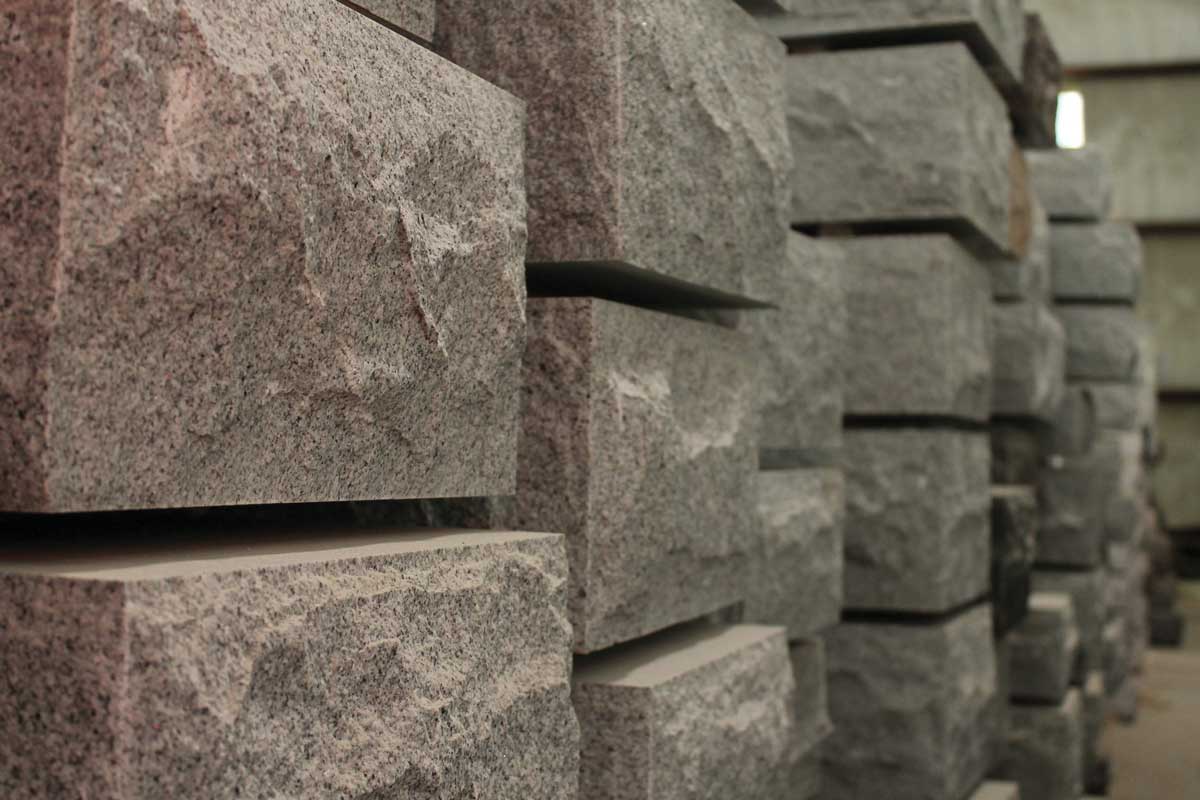Granite Facts
What is granite?
Granite is a tough, durable rock composed primarily of three approximately equal but different minerals, Potassium Feldspar, Plagiosclase Feldspar, and Quartz. These minerals are easy to see due to their different colors. The white mineral grains found in granite are Potassium Feldspar and Plagiosclase Feldspar. The light gray, glass-like grains are quartz, and the black, flake-like grains are biotite or black mica which is an accessory mineral found in the Elberton granite.
Granite and marble. How are they different?
Marble is simply limestone that has been compressed and/or heated deep within the earth's crust. Unlike granite, marble was never molten rock, but it may have been heated and squeezed enough for the limestone grains to bend and flow. Marble is also made up of only one mineral -- calcite -- a relatively soft mineral with a hardness of "3". Calcite is a common mineral -- all limestones and nearly all seashells are made of it, but it does not occur in granite. Because marble is made entirely of calcite, it is much softer than granite.
How was Elberton granite formed?
Elberton granite began 325 million years ago as a large, hot (1300 degrees to 1400 degrees Farenheit) mass of magma or molten rock. This magma originated when some of the earth's crust melted -- probably at a depth of about 11-12 miles. The magma rose upward and came to rest about nine miles beneath Elberton. There it cooled very slowly -- taking more than a million years -- and solidified into granite. That was more than 300 million years ago. Since then, the granite has been pushed upward, and the land above it has been removed by erosion. The result is a granite deposit that lies just beneath the earth's surface where it can be easily, safely and economically quarried.
How much granite is in the Elberton area?
The Elberton Granite deposit is a mass of granite approximately 35 miles long, six miles wide and most likely two to three miles deep. The total amount of granite in the Elberton area is approximately six million million tons. That is enough granite to fill the Rose Bowl nearly two million times.

How hard is Elberton granite? Why is it so hard?
The hardest material on earth, diamond, has a hardness of "10". It can only be scatched by other diamonds. The softest materials have a hardness of "1" and are easily scratched. Few materials, except precious stones are harder than "7". Elberton granite is very hard, "6"-"7", and is very tough to break due to its tightly bonded quartz and feldspar grains as well as their atomic structure. No other natural stone used for commercial purposes is any harder or more difficult to break than granite.
| Material | Hardness |
|---|---|
| Oak Wood | 2 |
| Glass | 5 |
| Steel | 6 |
| Elberton Granite | 6-7 |
| Diamond | 10 |
Crushing Strength
In compressive strength, ten samples of Elberton granites from seven separate quarries averaged 23,450 pounds per square inch (p.s.i.). Testing showed no significant difference to indicate granites from one producing area are more durable; all have adequate strength for any memorial or structural use For example, on the Washington Monument, the load bearing requirements for stone is equal to 600 p.s.i.
Monumental Stone Characteristics
Not all granites are classified by the U.S. Bureau of Mines as suitable for "monumental stone." According to the Bureau's standards for "Class 1" granites, they must meet exacting requirements such as uniform texture and color, freedom from flaws and general suitability for polishing and carving as well as resistance to weathering. Elberton blue-gray granites meet these requirements in every respect.
Endurance
Tests conducted by the Georgia Insitute of Technology on Elberton granites confirm an analysis made by the Bureau of Mines when testing all recognized "monumental grade granites" as quoted in Information Circular 7720; "While many trade names are applied to memorial stones and prospective users may raise questions as to whether these named varieties or types are superior to others, the Bureau of Mines has no data indicating that any of them is more enduring than any other. In fact all of the monumental granites produced by reputable firms in the well-known regions last so long with so little visible change that the factor of endurance should scarely be given consideration in making a choice. Selection may therefore be made on the basis of color, texture, design, and workmanship that best suit individual tastes."
For more information on granite and memorialization, please contact the Elberton Granite Association for a copy of the free publication "What is Granite?".
References
Bowles, Oliver, 1955, "Memorial Stone", Information Circular 7720, U.S. Bureau of Mines, pp. 1-6
Barton, William R., 1968, "Dimension Stone," Information Circular 8391, U.S. Bureau of Mines, pp. 1-140
Lewis, Jerry L., 1965, "A Program of Research for the Granite Industry In Elbert County, Georgia," Georgia Institute of Technology project #A-702
Stormer, John C., 1980, "Geological, Geochemical and Geophysical Studies of the Elberton Batholith, Eastern Georgia."
EGA Quality Report
The Stone Industry recognizes granite as one of the hardest of all natural stones. Elberton Granite has been a stone of choice for public and private memorials as well as countless commercial uses for almost 100 years. In 1969 the Elberton Granite Association contracted with the Georgia Institute of Technology (Georgia Tech) to run a blind test on samples of Elberton Granite as well as a few samples from other areas. The tests were done to determine the physical and mineral properties of Elberton Granite and how it compares with other granites. The results of these tests have been shared with the industry for decades.
Read more about the EGA Quality Report.


